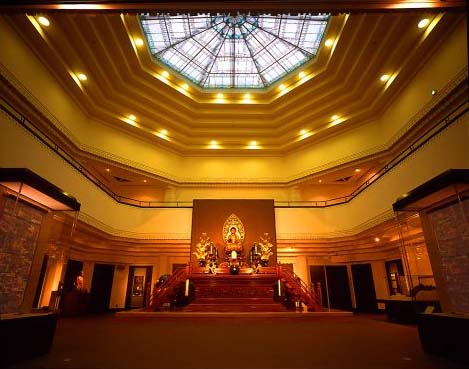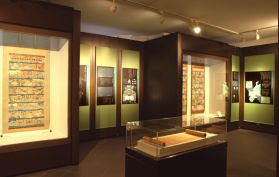The Museum of Zen Culture and History

To commemorate the University's 120th anniversary in 2002, the Museum of Zen Culture and History was established in the "Kounkan," which had been designated a Historical Building by the Tokyo Metropolitan Government. The Kounkan was later designated a Museum-Equivalent Establishment in November 2006.
The Kounkan houses the University's Permanent Exhibition of Zen culture and history on the first floor and a Temporary Exhibition on the second floor tracing the University's development form its start as a dormitory for students of Zen, "Sendanrin." The basement houses study and seminar rooms for the Museology course offered at Komazawa.
The Museum symbolizes the University as a school founded upon the teachings of Buddhism and the Soto sect of Zen Buddhism. It is hoped that the Museum, unique in its holdings in Japan and abroad, will contribute to the cultural development of the community as well as the university and the sect.
The Permanent Exhibition consists of Exhibition Room A, a space symbolizing Zen, and Exhibition Rooms B1 to B5, each with its own theme, which trace the history and culture of Zen focusing on the Soto sect. This Museum possesses a broad collection, ranging from calligraphy and pictures by Zen monks to artistic crafts symbolizing Zen culture and Buddhist art. Visitors are invited to explore the world of Zen and the founding spirit of the University.
Exhibition Room A: What is Zen?
In this space symbolizing Zen, the exhibition centers on home shrines (Sumidan) and a triptych known as Ichibutsuryoso (statures of Shakamuni, Dogen, and Keizan), and includes a recreation of the living space of trainee monks emphasizing simplicity, a Zen meditation statue, and musical instruments used in Zen temples.
Exhibition Room B-1: Origins of Zen
This exhibition traces the history of Zen from its origin to its introduction to Japan.
Exhibition Room B-2
Traces the history of the Soto sect from the foundation in Japan by Dogen to its growth throughout the country through the efforts of Keizan.
Exhibition Room B-3: the World of the Shobogenzo and the Denkoroku
Covers the thoughts and the transmission of the teachings of the Soto sect of Zen expressed in Dogen's Shobogenzo and Keizan's Denkoroku.
Exhibition Room B-4: Biographies of Zen monks
Introduces Zen monks active in the middle ages, early modern times, and modern times, and reveals the progress of the Soto sect from the perspective of social history.
Exhibition Room B-5: Zen Culture and History
Explores the influence of Zen on the culture and arts of Japan.
Lectures and Seminars
Events including lectures and seminars are organized throughout the year according to the Soto sect calendar of events.
Museology Course
The basement houses facilities for the Museology Course including a training room, a workroom, and an art appreciation room. The Course offers a certificate in Curatorship upon completion.
Kounkan


The University's former library, "Kounkan" was named after the Zen aphorism Kounshugetsu ("as if cultivating clouds and planting seeds on the moon, maintain high ideals and progress steadily"), and was designated a Historical Building by the Tokyo Metropolitan Government in 1999.
The Kounkan was originally built in 1925 as part of the reconstruction efforts after the Great Kanto Earthquake and the campus redevelopment project that coincided with Komazawa's promotion to university status. The floor plan consists of a central hall with a well unfolding from the two orthogonal lines at the center. The hall is in turn surrounded by lightening-shaped walls. The elevation view shows the building's eclecticism, incorporating motifs reminiscent of Frank Lloyd Wright, the Vienna Secession, and expressionism, all of which were popular architectural styles in the Taisho period. The symbolic structure of the central hall as a reading room suggests the architect's intention of elevating the activity of reading to a lofty status. It can be regarded as one of Eizo Sugawara's representative works, considering the originality and free eclecticism of the overall structure.
Hours
10:00-16:30 Monday through Friday (entrance allowed until 16:15)
- Admission free
- Wheelchair accessible (elevators and toilets available for wheelchair users)
